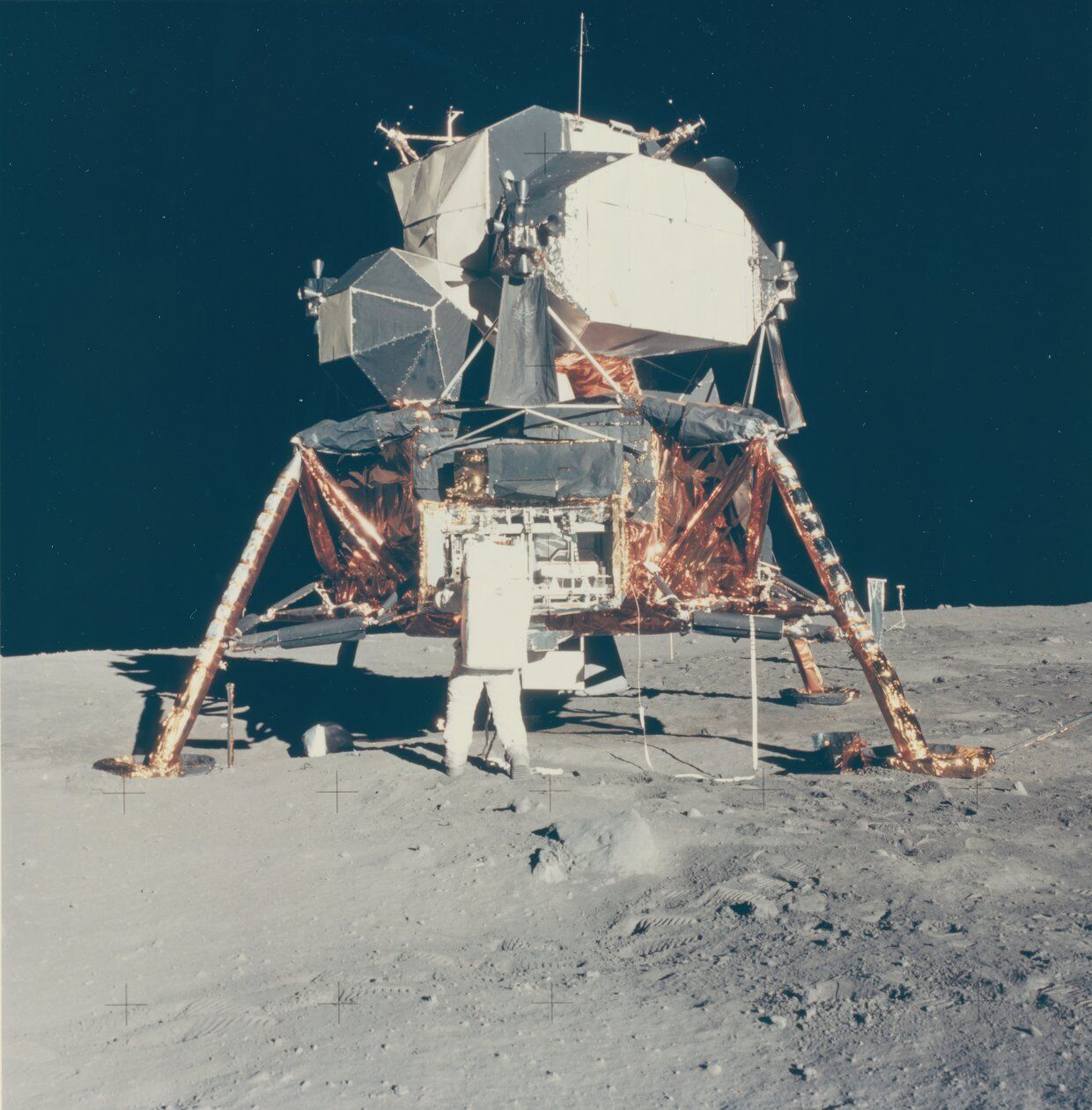Grumman and the Lunar Module
 by, Wendy Elkis Girnis, HHS Class of 1977
by, Wendy Elkis Girnis, HHS Class of 1977
If you asked your friends where their fathers worked back in the 1960s, '70s, and '80s, chances are that they would say one of the aerospace companies on Long Island. Companies like Astrosystems, Hazeltine, Gould, Lambda, Harris, Eaton, Fairchild/Republic, and others employed over 100,000 people. Grumman had the largest workforce of all of them.
Grumman's Early Days
Grumman, founded in the 1930s, produced Bi-Planes before WWII. Once the war was over, it began to produce jet fighters. Some of the planes that Grumman built were well known on Long Island. Those were
- Grumman F4F Wildcat
- Grumman TBF Avenger
- Grumman F6F Hellcat
- Grumman A-6 Intruder
- Grumman F-14 Tomcat
A New Frontier
But in the 1960s, Grumman’s focus shifted to the Lunar Module, winning the contract to design and build it in 1962. At least 10,000 people were involved in its production, from engineers to production workers.
Man's First Steps
The Lunar Module, or LM, was designed to carry a crew of two to the moon’s surface. Once on the surface of the moon, the astronauts would use it as a base. When the astronauts were ready to return to the main capsule, the top portion of the LM would serve as transport. My father worked for Astrosystems in New Hyde Park at that time. He was in the Quality Control Department and was responsible for checking the quality of the wire harnesses to make sure they were built to the specifications on the blueprint/installation instructions. On July 20, 1969, we all watched as Apollo 11 took off for the moon. On July 21st, we watched as the Lunar Module named the Eagle, landed on the moon at Tranquility Base. I think everyone in the country Armstrong snaps a picture of Aldrin 1969 celebrated this accomplishment. I remember we banged pots and yelled and shouted with joy. We listened to Neil Armstrong's words as he became the first man to walk on the surface of the moon, followed by Buzz Aldrin 19 minutes later. Then, after spending just over 21 hours on the moon, Armstrong and Aldrin entered the Lunar Module to start the journey home. I think you could have heard a pin drop in our house as we held our breath, waiting for the LM to take off to meet up with the command module. My dad was so nervous. If the engines failed to light, that meant that the wiring harnesses failed, and he would have felt
Armstrong snaps a picture of Aldrin 1969 celebrated this accomplishment. I remember we banged pots and yelled and shouted with joy. We listened to Neil Armstrong's words as he became the first man to walk on the surface of the moon, followed by Buzz Aldrin 19 minutes later. Then, after spending just over 21 hours on the moon, Armstrong and Aldrin entered the Lunar Module to start the journey home. I think you could have heard a pin drop in our house as we held our breath, waiting for the LM to take off to meet up with the command module. My dad was so nervous. If the engines failed to light, that meant that the wiring harnesses failed, and he would have felt  Leaving the moonthat he failed. We watched as the engines lit up, and it finally took off from the moon. I remember hearing my dad start breathing again, and he yelled, "YES!" I am sure that those same emotions went through the 10,000 employees at Grumman who worked on the LM, as well as all of the people who worked on the outsourced materials.
Leaving the moonthat he failed. We watched as the engines lit up, and it finally took off from the moon. I remember hearing my dad start breathing again, and he yelled, "YES!" I am sure that those same emotions went through the 10,000 employees at Grumman who worked on the LM, as well as all of the people who worked on the outsourced materials.
Grumman's Life Raft
During the Apollo 13 mission, though, the Lunar Module was used as a literal life raft. Apollo 13 was launched on April 11, 1970. Two days after its launch, an oxygen tank exploded. That not only caused the mission to be aborted, but it also left the astronauts, Lovell, Swigert, and Haise, in a precarious position. The three astronauts needed to move into the Lunar Module, which was designed to handle two men. It only had enough oxygen for 45 hours but needed to support three men for 90 hours. The astronauts became inventors. They reworked the command modules' lithium hydroxide canisters to work in the LM to clear out the carbon dioxide from the air. Shortly before reaching Earth, the astronauts moved back into the command module and reentered the Earth's atmosphere safely. I remember being a student at Old Country Road Elementary School at the time. A television was set up in the auditorium/gym. We were brought in to watch Apollo 13 reenter the atmosphere and return home. I was so engrossed in watching the television that I never noticed that the students went back to class, and I sat there, eyes glued to the TV, watching and praying they would get home safely, which they did. The astronauts owed their lives to Grumman's Lunar Module.
The first LM was received by the Kennedy Space Center in June of 1967 and launched into space on January 22, 1968. The last of the Lunar Modules never went into space and is on display at the Cradle of Aviation Museum on Long Island.
References:
- Cradle of Aviation Museum - Aviation Heritage of Long Island https://www.cradleofaviation.org/history/history/heritage.html#:~:text=The%20demands%20of%20war%20brought,the%20war%2C%20Grumman%20and%20Republic.
- The American Society of Mechanical Engineers #218 Apollo Lunar Module LM-13 https://www.google.com/search?q=production+lunar+module&oq=production+lunar+module&gs_lcrp=EgZjaHJvbWUyBggAEEUYOTIHCAEQIRigATIHCAIQIRigATIHCAMQIRifBTIHCAQQIRifBTIHCAUQIRifBTIHCAYQIRifBTIHCAcQIRifBTIHCAgQIRifBTIHCAkQIRifBdIBCDYzMDdqMGo3qAIAsAIA&sourceid=chrome&ie=UTF-8
- NASA Space Science Data Coordinated Archive https://nssdc.gsfc.nasa.gov/nmc/spacecraft/display.action?id=1970-029C
- Apollo 11 https://en.m.wikipedia.org/wiki/Apollo_11
Pictures:
- Bi-Plane https://en.wikipedia.org/wiki/Grumman_FF
- Working on the LM https://yesterdaysamerica.com/remembering-the-apollo-program/
- Tomcat- https://aircraft.fandom.com/wiki/Grumman_F-14_Tomcat
- Intruder - https://www.flickr.com/photos/31469080@N07/15888872288
- Avenger - https://en.wikipedia.org/wiki/Grumman_TBF_Avenger
- F6F-https://planehistoria.com/grumman-f6f-hellcat/
- F4F-https://www.thoughtco.com/grumman-f4f-wildcat-2361519
- Avenger https://www.americanairpowermuseum.com/grumman-tbm-3e-avenger/#:~:text=History%3A,bomber%20first%20flown%20in%201941.
- Armstrong pic aldrin https://www.meisterdrucke.uk/fine-art-prints/Neil-Armstrong/1156971/Buzz-Aldrin-with-Apollo-11-Lunar-Module-on-the-Moon,-1969.html
- Leaving Moon https://airandspace.si.edu/stories/editorial/leaving-moon-watching-home
Video of Moon Landing
- Video of astronauts leaving LM https://youtu.be/S9HdPi9Ikhk?si=PAbjMvg_Eel64gOE

